Last Updated on June 15, 2023 by Grow with Bovees
There’s nothing worse than a brown lawn in a sea of green. Fortunately, a little more brown—fertilizer this time—and your lawn may become the greenest of all.
Instead of using synthetic fertilizers, consider using organic lawn fertilizer for your lawn growth. With all-natural, chemical-free ingredients and a little patience on your part, you can go from the neighborhood dud to the neighborhood show-house by using purely organic lawn food.
The best organic lawn fertilizers that are plant based, can contain ingredients such as, cottonseed meal, blood meal, feather meal, food waste and compost, alfalfa meal, bone meal, soybean meal, pasteurized poultry manure, loads of amino acids and heat dried microbes, just to name a few.
Since there are so many organic yard fertilizer products out there, we’ve narrowed the selection down. The best organic fertilizer for your lawn is among the following contenders:
Our Quick Picks of Best Organic Lawn Fertilizers;






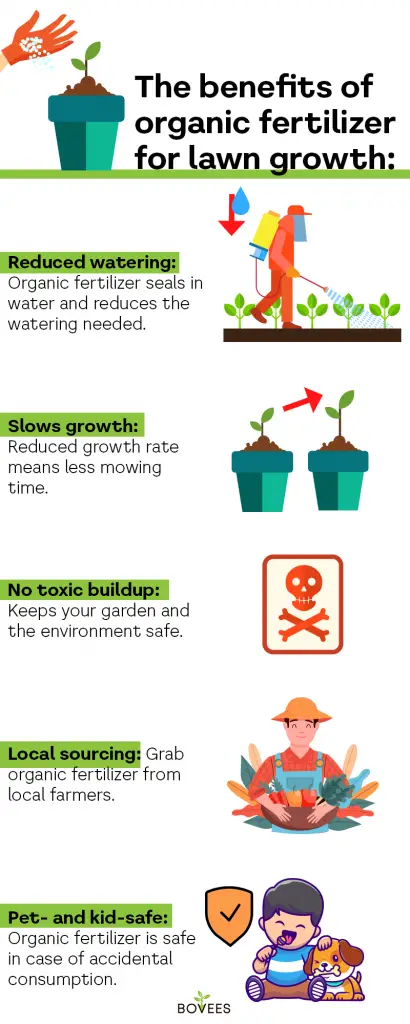
Preparing Your Lawn for Organic Lawn Fertilizers
As nice as it would be to switch seamlessly to organic lawn fertilizers, it’s impossible. There’s some prep-work involved if you’ve been using a synthetic fertilizer rather than purely organic lawn food.
Before you’re ready to use an organic slow release fertilizer on your lawn, ask yourself if you’re willing to do the work.
Do A Soil Test
Every lawn grass type is different and craves an array of nutrients it lacks. So, test your soil pH (see our soil tester review), to see what your lawn needs before applying natural lawn food.
Your lawn requires more nutrients than you may realize. For example, mineral langbeinite will give it the magnesium it needs, where gypsum restores the lawn’s appropriate amount of calcium.
To figure out what plant food you need to buy, fill two cups with soil, taking the samples from various spots around the lawn.
Next, find a soil testing service near you. Some universities offer this or visit your local garden center to see if they can do it.
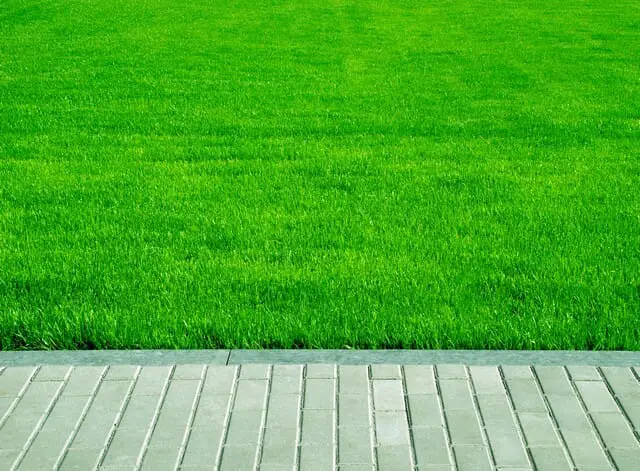
Compost
To help your soil free itself from its reliance on synthetics, you must start applying compost to your lawn. Composting improves your soil’s structure, which can be damaged by incorrect or a lack of care.
You’ll need organic compost for your lawn, of course—made of dead garden plants and other organic matter. If you want to save money, you should collect your own garden’s waste and plant debris from home, such as potato skins and other peelings, and start your own compost pile.
Most yards will have a suitable site for a compost bin, even if it’s just a small one.
Spread your composted waste products with a compost fork, all over the lawn, about half an inch thick. Also consider spraying your lawn with compost tea monthly. Continue this after your switch to the best organic lawn fertilizers.
Organic lawn food can do the work on its own, but should it? You’ll benefit more from multiple traditional lawn care methods.
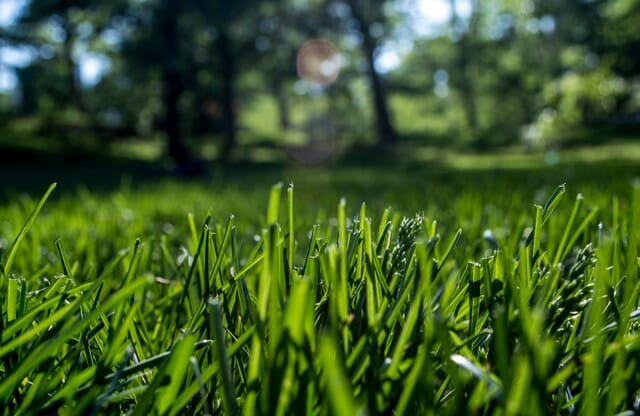
Preparing Your Lawn for Amending It With Organic Yard Fertilizer
Once you break the synthetic-addiction your lawn has due to conventional fertilizers, you can start the prep work for the actual organic-fertilizing process.
Clean Up For A Healthy Lawn
Is there compost leftover on your lawn that didn’t break down? Stray leaves and twigs from nearby trees?
Get yourself a backpack leaf blower and remove that debris off your lawn to make space for the slow release organic nitrogen fertilizer.
You could use a rake, but do you want to risk disturbing your soon-to-be-fertilized soil? Plus, the blower will speed the lawn cleaning process up.
Mow It Short
Purely organic lawn food won’t save an overgrown lawn that is already sprouting unwanted weeds. Mow your lawn short—leave maybe an inch of grass sprouting—and properly dispose of the grass clippings.
Kill Undesirables
Apply a gentle weed killer and pre-emergent to rid yourself of garden growth pests, weed growth and potential crabgrass.
Try to go organic here—you don’t want to ruin your hard work. If you can get an organic pre-emergent/weed killer combo, it’s far more efficient and easier on the wallet than products made of synthetic chemicals.Never neglect this step, especially the pre-emergent.
You can kill and pull weeds any time, but if crabgrass sprouts on your lawn, it’s a battle you’ll have for the entire sunny season.
Reseed
Once you’ve applied the weed killer and re-emergent treatment successfully, reseed your lawn. Consider using organic grass seed for this.
This step is best done in fall, so your new grass will germinate and sprout in time for summer.
Reseed shortly before you use organic lawn food, but don’t drown the new seeds in the lawn food immediately. Wait for the new lawn to sprout a little.
It also helps if you overseed. This way, the seeds are more likely to fill out brown patches on the lawn if some fail to germinate.
Await Greener Grass
You’ve done as much as you can do—how do you know your grass is ready for purely organic fertilizer?
The lawn should start to grow greener if you’ve followed all the steps laid out so far. It won’t be perfect; it’s still unfed after all, but when you see deep green lawn patches appearing, you know the lawn is well-prepped for organic lawn fertilizer.
Organic Fertilizers Reviews: The Top Contenders
There’s no need to fret about where to buy the best organic lawn fertilizer free of harmful chemicals. We have some of the best options for you right here, which we selected after some in-depth research on lawn care.
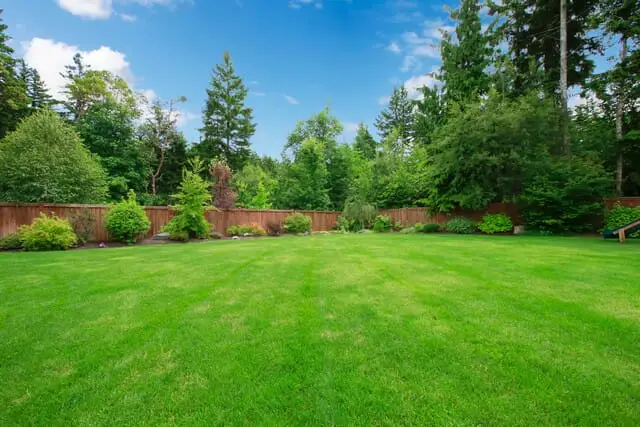
1. Espoma EOFW30 Organic Fall Fertilizer
Do you want a lush, green yard even in winter? Here’s a lawn feed you apply in the fall, and it keeps your lawn emerald until spring.
A bag of Espoma organic lawn food feeds 5,000 square feet of lawn with its sulfate of potash and feather meal-poultry manure combination.
It’s a granulated manure—the best organic lawn fertilizer type—you can easily use with a spreader if you have a lot of lawn to cover. Although “easily” refers only to your efficiency in spreading it—it’ll be a tough job if you’re sensitive to foul odors.
Luckily, consumers found that the smell dissipated upon watering, which didn’t occur with other natural fertilizers for organic lawn care that they’d used.
Besides the stench, the best kind of organic lawn fertilizer is harmless, and Espoma is no different—it’s safe for use if you have pets.
Barring the smell, customers say the only downside of this organic lawn care is the hefty price for the 30-pound bag, but many are in agreement that it’s worth it for the best organic lawn care.
Pros
- Keeps lawns alive in winter.
- Safe for pets and the environment.
- Terrible odor goes away when watered.
- Highly effective fertilizer.
- Large bag works for enormous lawns.
Cons
- Foul odor.
- Quite pricey.
2. Milorganite 0636 Organic Nitrogen Fertilizer
If you’re looking for a similar-sized bag to the previous product, but at a lower price, Milorganite organic lawn fertilizer is an excellent choice. Even better, you can buy it in bulk, and it’s fantastic for lawns lacking in nitrogen.
Milorganite is the best organic nitrogen fertilizer for use on golf courses, according to the manufacturer, which isn’t surprising, thanks to its 32-pound size—it goes a long way.
Another reason this is one of the best organic lawn fertilizers for golf courses — which is often bermuda grass — is that it also treats the grass, so the plant growth is slower, reducing the amount of mowing and watering it needs.
This also makes it an excellent choice for people with a large garden or green area around their house.
Customers had fantastic results with this organic lawn care substance. The images they post online reveal it turns their lawns from patchy and varying in color to a deep, rich, uniform green.
As well as turning the average lawn into a golf-course like dream, customers say it also repels deer.
A small proportion of users say that you need a lot of the product to produce a measurable difference, some state you’ll need double the amount of other similar products. If this is so, it is no more cost-effective than the top product.
They also say it stinks with the odor hanging around for up to two weeks after application. This is unfortunately the case with most organic lawn fertilizers.
Pros
- You can buy it in bulk for a reduced price.
- Turns patchy lawns into uniform, lush lawn.
- Compatible with all spreaders.
- High nitrogen lawn fertilizer.
- Reduces mowing and watering time.
- Slowly releases nutrients, so you have to fertilize less often.
Cons
- Lingering stench.
- It takes a sizable amount to start working.
3. Green Envy Liquid Feed
Not everyone wants to follow the seasons, and sometimes you only have time for lawn care in winter. Luckily, this all – season lawn food is effective all year-round and harmless — unlike synthetic fertilizers — to the entire family—kids and pets included.
This all season lawn food is not just safe in case of accidental consumption, though—it’s safe for them to run on immediately after application. This won’t affect the results, which should start to show after 1–3 weeks.
The timing of results is weather-dependent after the initial application.
Application-wise, the manufacturer recommends you mix and spray as per instructions, and apply the fertilizer once per season.
You can also use the fertilizer before or after sewing your seeds, making it highly versatile and well-suited to anyone’s needs and time limitations.
Customers find it works well either way. It won’t fill in patches if you don’t seed your lawn, but it makes for a greener lawn turning it to a dark green and thickens it up.
Pros
- Can be used in any season.
- You can walk on the lawn immediately afterward.
- Use before or after seeding.
- Safe in case of accidental consumption.
- The smell is subtle and fades fast.
Cons
- Can turn the lawn yellow if piled on thickly.
- It won’t rejuvenate patches of dead grass.
4. Safer Brand 9334 Lawn Restore Fertilizer
For a fast-acting fertilizer, here’s one to look into. Safer Brand’s fertilizer gets your lawn green in only 3–5 days.
Not only that, but a little of this goes a long way. One 25-pound bag covers up to 6,250 square feet.
The fast results come from how this fertilizer directly targets the grass’s roots. It strives to make the root system more robust, thickening your lawn and rejuvenating it in the process.
It also strives to keep your lawn in prime condition all year as it wants to help the grass withstand temperature fluctuations and even drought.
Although, customers say a previous version of the same product was better. This one, apparently, smells worse and is messy to spread.
However, the quick results and the pet-and-kid-safe formula may outweigh this. Not only can the fertilizer thicken existing grass, but it also helps fill in patches and reduce how often you need to water the lawn.
Customers say there are better brands out there, which is true; after all, this is #4 on our list. But for a thin spreading substance that works swiftly, it’s an excellent product.
Pros
- Fast-working.
- Strengthens roots.
- Reduces watering time.
- Works all year.
- Safe for kids and pets.
- Rejuvenates dead patches.
- A little goes a long way.
Cons
- Foul stench.
- Messy to apply; small particles that fly in the breeze.
- Not as impressive as other brands.
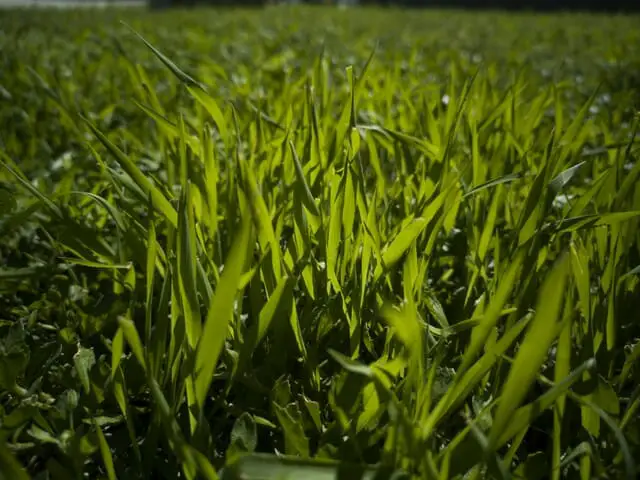
5. Jonathan Green 12192 Coverage Love Your Soil
Last but not least, we have a budget pick. For half the price of the selection above, you can get 1,000 square feet of grass growing healthy again. This isn’t a pick for someone with lots of land, but a small front lawn will benefit greatly.
You can also buy in bulk for more extensive areas at a very reasonable price—15,000 square foot coverage, for not much more cost than our top pick.
Quantities and pricing aside, this is an excellent and natural organic fertilizer for lawn growth. It feeds the soil and the roots, with users claiming it’s most effective in spring due to the soil’s warmth.
They state that warmth aids the soil’s microbes, which, in turn, release nutrients, although we haven’t found any studies backing the claim about soil microbes.
Once on, it keeps the grass healthy year-round and makes your soil much easier to deal with. It loosens the hard, compacted stuff to let the grass grow at a consistent rate. Even Florida-based customers with lawns on sandy soil found it a tremendous help.
As well as aiding the soil, this Jonathan Green organic lawn fertilizer turns your yellow lawn spots lush and makes the grass greener.
The chief complaints customers have aren’t about performance, but the size of the smallest bag. They compare it to a bag of coffee grounds and say you’re better off buying a larger bag—which eliminates the budget-pick part.
Some also say the company sells bags below the advertised weight across all sizes.
Pros
- Affordable, if you feel the bag is big enough.
- Helps keep soil moist and loose in winter.
- Darkens and thickens grass nicely.
- Creates a consistent growth rate.
Cons
- Some bags are underweight.
- Budget pick is allegedly tiny.
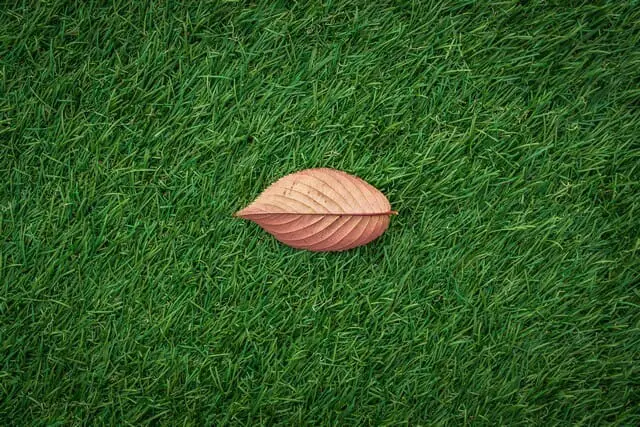
Green Color, Green Practice: The Benefits of Organic Lawn Fertilizer
With the products above in mind, you may wonder why you should bother with organic lawn fertilizer. It’s all so pricey!
The best organic fertilizers are worth the price, though, if you care about the environment. The benefits of going organic go well beyond lush lawns, attaining a healthy soil and glamorous green grasses and beautiful flower beds.
Chemicals are toxic. There’s a reason you can’t consume harsh chemicals without serious consequences to your health. They may have their benefits for some living things, but conventional fertilizers are detrimental to others.
Using chemicals has a severe negative impact on the environment. Despite getting your grass looking its best, these chemical-ridden fertilizers also:
- Release greenhouse gasses into the atmosphere.
- Get washed into rivers causing algal blooms, which kills fish.
- Increase soil nitrate levels too much.
So, chemicals may green your grass, but they make the planet less green in the process—their beauty is only surface-deep.
Since organic fertilizers are all-natural, they break down with ease while releasing excess nitrogen, but not at an air-polluting rate.
Natural lawn food also doesn’t chemically pollute water but settle harmlessly to the riverbed, with the rest of the dirt. If marine life consumes it, at most, they get a foul taste in their mouths.
Other natural fertilizers not mentioned above that are worth looking into are Andersons Innova Organic Fertilizer and Scotts Natural Lawn Food.
Best Practices for Green Lawns With the Best Fertilizer
Now you’ve made the green choice, let’s put it into action. Here are the best fertilization practices for a green lawn:
Stay Loyal to Organic: Organic vs. Chemical
Outside the negative impacts of chemical fertilizers, they’re just not as good for your lawn as the organic stuff, whether you are using them on warm or cool season grasses.
Organic Creates Stamina
Is it odd to talk about grass that has stamina? Maybe, but it’s true. Organic fertilizers give your grass and soil the ability to retain not just water, but nutrients too. With moist and well-fed roots, your grass and other plants can strengthen over time.
You Can’t Over Fertilize Easily
While chemical fertilizers are there to get the job done and get it done quickly, most organic fertilizers release their nutrients slowly as they break down.
With this slow-release nature of organic fertilizer, it becomes increasingly difficult to over-fertilize the lawn, minimizing the threat of a burned lawn.
There’s No Toxic Buildup
The chemicals in chemical fertilizer contribute to your plants’ health in the short run, but what about the long term?
Many chemicals—like chloride—used in a variety of products are poisonous to living things, and some contain salt.
There is also the possibility of burning the grass with chemical fertilizers, so that’s something to consider. Salt damages plants, making it deadly if enough of it builds up in your lawn. Prevent a burned lawn by using a slow release organic fertilizer.
Organic is Environmentally Friendly
Since it’s all-natural in both creation and breakdown, organic fertilizer is environmentally friendly. With the ever-more startling warnings from scientists that global warming is fast increasing, every little helps.
Local Sourcing
You can find locally sourced organic fertilizers at some farmer’s markets or dairy farms. It’s plausible that the farmers gather and sell composted manure fertilizer. This is an excellent way to procure manure if you’re so environmentally conscious that you fear the impact of online shopping on the environment. You can also check for local lawn care service providers who will come and do all the work for you!
Time It Well
With your fertilizer selected, it’s time to choose the right time to fertilize your lawn. You can indeed use some organic fertilizers year-round, but they work most efficiently in warm soil.
Consider buying a soil thermometer to check when your soil is at a moderate heat. As seasons can be unpredictable, it’s best to be sure rather than solely base your decision on the time of year.
Get Granules
Liquid fertilizer exists and will spread much faster than fertilizer from a bag. Unfortunately, this isn’t always easy to spread evenly and may require special tools to apply correctly.
Granulated fertilizer in a broadcast spreader is more straightforward and ensures you cover your whole lawn evenly.
Water Well, Yet Infrequently
The more you water your lawn, the more you’re feeding the grass. It’ll grow, but it will use up its nutrients quickly.
So, don’t overwater your lawn, or you’ll have to fertilize more frequently to replenish it—think every six weeks as opposed to every eight.
Different fertilizers will have various watering instructions, so always read the bag.
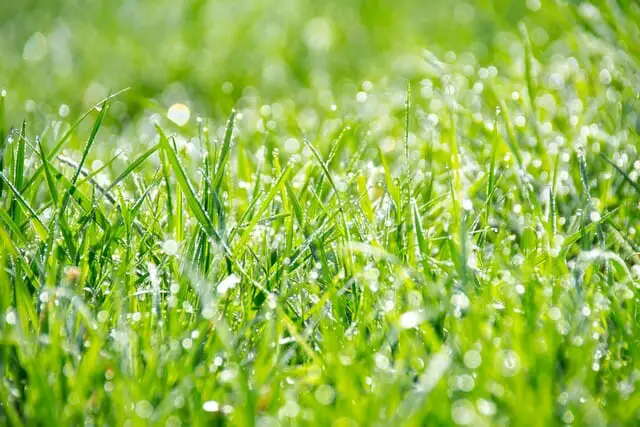
Go Green, Stay Green
If you’re still not convinced that you should go with organic lawn fertilizer over synthetic, you’re probably beyond persuasion by now.
However, if we’ve converted you, the best organic lawn fertilizer is Espoma EOFW30 Organic Fall Fertilizer. You just can’t argue with the before and after pictures that customers posted online.
Espoma is effective, works quickly, and the smell disappears after a little water. This leaves you with a lawn that’s not only lush but won’t send people running away with their mouth and nose covered.
It’s quite pricey, but a little goes a long way, and we think it’s worth the investment.

